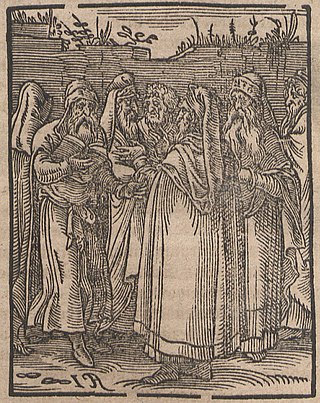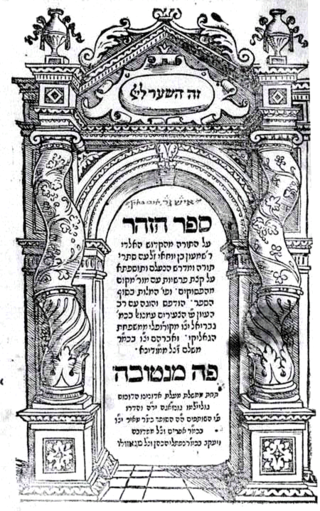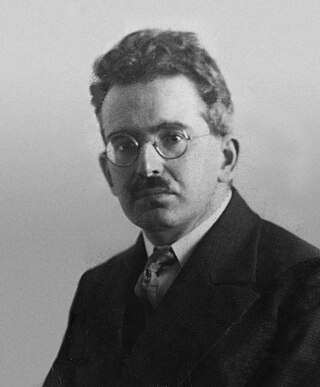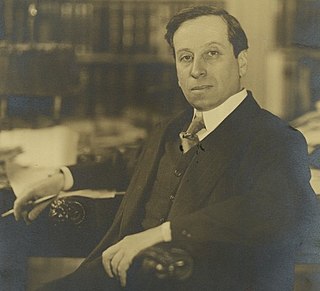Related Research Articles

Gnosticism is a collection of religious ideas and systems that coalesced in the late 1st century AD among Jewish and early Christian sects. These various groups emphasized personal spiritual knowledge (gnosis) above the proto-orthodox teachings, traditions, and authority of religious institutions.

Kabbalah or Qabalah is an esoteric method, discipline and school of thought in Jewish mysticism. A traditional Kabbalist is called a Mekubbal. The definition of Kabbalah varies according to the tradition and aims of those following it, from its origin in medieval Judaism to its later adaptations in Western esotericism. Jewish Kabbalah is a set of esoteric teachings meant to explain the relationship between the unchanging, eternal God—the mysterious Ein Sof —and the mortal, finite universe. It forms the foundation of mystical religious interpretations within Judaism.

The Zohar is a foundational work of Kabbalistic literature. It is a group of books including commentary on the mystical aspects of the Torah and scriptural interpretations as well as material on mysticism, mythical cosmogony, and mystical psychology. The Zohar contains discussions of the nature of God, the origin and structure of the universe, the nature of souls, redemption, the relationship of Ego to Darkness and "true self" to "The Light of God".

Metatron, or Matatron, is an angel in Judaism, Christianity, and Islam mentioned three times in the Talmud, in a few brief passages in the Aggadah, and in mystical Kabbalistic texts within Rabbinic literature. The figure forms one of the traces for the presence of dualist proclivities in the otherwise monotheistic visions of both the Tanakh and later Christian doctrine. In the Jewish kabbalistic tradition, he is sometimes portrayed as serving as the celestial scribe. The name Metatron is not mentioned in the Torah or the Bible, and how the name originated is a matter of debate. In Islamic tradition, he is also known as Mīṭaṭrūn, the angel of the veil.

The Star of David is a generally recognized symbol of both Jewish identity and Judaism. Its shape is that of a hexagram: the compound of two equilateral triangles.

Walter Bendix Schönflies Benjamin was a German Jewish philosopher, cultural critic, media theorist, and essayist. An eclectic thinker who combined elements of German idealism, Romanticism, Western Marxism, Jewish mysticism, and Neo-Kantianism, Benjamin made influential contributions to aesthetic theory, literary criticism, and historical materialism. He was associated with the Frankfurt School and also maintained formative friendships with thinkers such as playwright Bertolt Brecht and Kabbalah scholar Gershom Scholem. He was related to German political theorist and philosopher Hannah Arendt through her first marriage to Benjamin's cousin Günther Anders, though the friendship between Arendt and Benjamin outlasted her marriage to Anders. Both Arendt and Anders were students of Martin Heidegger, whom Benjamin considered a nemesis.
Academic study of Jewish mysticism, especially since Gershom Scholem's Major Trends in Jewish Mysticism (1941), draws distinctions between different forms of mysticism which were practiced in different eras of Jewish history. Of these, Kabbalah, which emerged in 12th-century southwestern Europe, is the most well known, but it is not the only typological form, nor was it the first form which emerged. Among the previous forms were Merkabah mysticism, and Ashkenazi Hasidim around the time of the emergence of Kabbalah.

Gershom Scholem was a German-born Israeli philosopher and historian. Widely regarded as the founder of modern academic study of the Kabbalah, Scholem was appointed the first professor of Jewish mysticism at Hebrew University of Jerusalem.
The Hasidim of Ashkenaz were a Jewish mystical, ascetic movement in the German Rhineland during the 12th and 13th centuries.

Doctor Faustus is a German novel written by Thomas Mann, begun in 1943 and published in 1947 as Doktor Faustus: Das Leben des deutschen Tonsetzers Adrian Leverkühn, erzählt von einem Freunde.
Ein Sof, or Eyn Sof, in Kabbalah, is understood as God prior to any self-manifestation in the production of any spiritual realm, probably derived from Solomon ibn Gabirol's term, "the Endless One". Ein Sof may be translated as "unending", "(there is) no end", or infinity. It was first used by Azriel, who, sharing the Neoplatonic belief that God can have no desire, thought, word, or action, emphasized by it the negation of any attribute. Of the Ein Sof, nothing ("Ein") can be grasped ("Sof"-limitation). It is the origin of the Ohr Ein Sof, the "Infinite Light" of paradoxical divine self-knowledge, nullified within the Ein Sof prior to creation. In Lurianic Kabbalah, the first act of creation, the Tzimtzum self "withdrawal" of God to create an "empty space", takes place from there. In Hasidic Judaism, the Tzimtzum is only the illusionary concealment of the Ohr Ein Sof, giving rise to monistic panentheism. Consequently, Hasidism focuses on the Atzmus divine essence, rooted higher within the Godhead than the Ein Sof, which is limited to infinitude, and reflected in the essence (etzem) of the Torah and the soul.
Hasidic philosophy or Hasidism, alternatively transliterated as Hasidut or Chassidus, consists of the teachings of the Hasidic movement, which are the teachings of the Hasidic rebbes, often in the form of commentary on the Torah and Kabbalah. Hasidism deals with a range of spiritual concepts such as God, the soul, and the Torah, dealing with esoteric matters but often making them understandable, applicable and finding practical expressions.

Frankism was a Sabbatean Jewish religious movement of the 18th and 19th centuries, centered on the leadership of the Jewish Messiah claimant Jacob Frank. Frank rejected religious norms and said that his followers were obligated to transgress as many moral boundaries as possible. At its height it claimed perhaps 50,000 followers, primarily Jews living in Poland, as well as in Central and Eastern Europe.

Robert Eisler was an Austrian Jewish polymath who wrote about the topics of mythology, comparative religion, the Gospels, monetary policy, art history, history of science, psychoanalysis, politics, astrology, history of currency, and value theory. He lectured at the Sorbonne and Oxford, served briefly on the International Committee on Intellectual Cooperation in Paris after World War I, and spent fifteen months imprisoned in Dachau and Buchenwald, where he developed heart disease. He is best remembered today for advancing a new picture of the historical Jesus based on his interpretation of the Slavonic Josephus manuscript tradition, proposing a dual currency system to control inflation, and arguing for a prehistoric derivation of human violence in Man into Wolf: An Anthropological Interpretation of Sadism, Masochism, and Lycanthropy. His life and work intersected with those of Sigmund Freud, Carl Jung, Alois Riegl, Gilbert Murray, Karl Popper, Hugo von Hofmannsthal, G. R. S. Mead, Aby Warburg, Fritz Saxl, Gershom Scholem, Oskar Goldberg, Martin Buber, and Walter Benjamin.
Lurianic Kabbalah is a school of Kabbalah named after Isaac Luria (1534–1572), the Jewish rabbi who developed it. Lurianic Kabbalah gave a seminal new account of Kabbalistic thought that its followers synthesised with, and read into, the earlier Kabbalah of the Zohar that had disseminated in Medieval circles.

Erich Unger (1887-1950) was a Jewish philosopher of standing who published many articles and a number of books, many of them in his native tongue, German. His writings cover a wide range of topics: poetry, Nietzsche, political theory, general philosophy and Jewish philosophy.

Werner Scholem was a member of the German Reichstag from 1924 to 1928 and a leading member of the Communist Party of Germany. Scholem and his wife, Emmy, were portrayed in the 2014 documentary "Between Utopia and Counter Revolution".
Kabbalah, the central system in Jewish mysticism, uses anthropomorphic mythic symbols to metaphorically describe manifestations of God in Judaism. Based on the verses "God created man in his own image, in the image of God created he him; male and female created he them" and "from my flesh shall I see God", Kabbalah uses the form of the human body to describe the structure of the human soul, and the nature of supernal Divine emanations. A particular concern of Kabbalah is sexual unity between male and female potencies in Divinity on high, depicted as interaction of the two sides in the sephirot, between archetypal partzufim, and the redemption of the exiled Shekhinah from captivity among the impure forces below.

Yehuda Liebes is an Israeli academic and scholar. He is the Gershom Scholem Professor Emeritus of Kabbalah at the Hebrew University of Jerusalem. Considered a leading scholar of Kabbalah, his research interests also include Jewish myth, Sabbateanism, and the links between Judaism and ancient Greek religion, Christianity, and Islam. He is the recipient of the 1997 Bialik Prize, the 1999 Gershom Scholem Prize for Kabbalah Research, the 2006 EMET Prize for Art, Science and Culture, and the 2017 Israel Prize in Jewish thought.
"On Language as Such and on the Language of Man" is the first of an uncompleted trilogy of essays articulating a metaphysics or post-metaphysics of language in and as the name of God, written by Walter Benjamin, in response to a series of questions raised by Gershom Scholem in a conversation that began at a villa in the German countryside at the end of the summer in 1916. The second fragment in this trilogy is "On the Mimetic Faculty," written from exile in 1932–1933. The piece "On Language" constitutes the earliest major artifact of Benjamin's thought, preceded only by a few speeches that he'd given in the debating society of Berlin's Jewish Youth Movement, and some articles he'd written for the banned antiwar student journal Der Anfäng.
References
- ↑ "Gershom Scholem, Oskar Goldberg, and the Meaning of Jewish History", Transfinite Life, Indiana University Press, pp. 162–203, doi:10.2307/j.ctt200609z.10, ISBN 978-0-253-03016-0 , retrieved 2021-02-19
- ↑ Pizer, John; Voigts (1994). "Oskar Goldberg. Der Mythische Experimentalwissenschaftler. Ein Verdrangtes Kapitel Judischer Geschichte" . MLN. 109 (3): 563. doi:10.2307/2904666. ISSN 0026-7910. JSTOR 2904666.
- 1 2 3 4 Friedlander, Judith (1992). "Religious Metaphysics and the Nation-State: The Case of Oskar Goldberg". Social Research. 59: 151–168 – via JSTOR.
- ↑ Mann, Thomas (1965). Doktor Faustus. New York: Alfred A. Knopf. p. 278.
- 1 2 Scholem, Gershom (1980). From Berlin to Jerusalem. New York: Schocken. p. 131. ISBN 0-8052-3738-0.